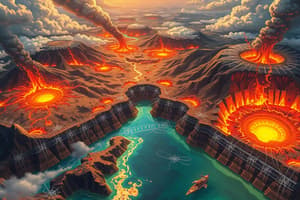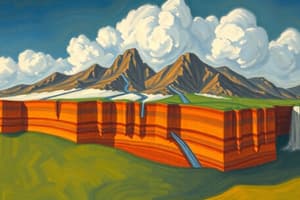Podcast
Questions and Answers
What does Bob Dziak study in a unique way?
What does Bob Dziak study in a unique way?
- Ocean currents
- Plate boundaries (correct)
- Atmospheric layers
- Marine life
Which government department does Bob Dziak work for?
Which government department does Bob Dziak work for?
- National Oceanic and Atmospheric Administration (NOAA) (correct)
- National Aeronautics and Space Administration (NASA)
- Environmental Protection Agency (EPA)
- Federal Bureau of Investigation (FBI)
Where did Dziak's team place the hydrophones to study the ocean floor?
Where did Dziak's team place the hydrophones to study the ocean floor?
- Mediterranean Sea
- Bermuda Triangle
- Challenger Deep (correct)
- Great Barrier Reef
What are hydrophones?
What are hydrophones?
What surprised Dziak and his team about the sounds they heard at Challenger Deep?
What surprised Dziak and his team about the sounds they heard at Challenger Deep?
In which landform is Challenger Deep located?
In which landform is Challenger Deep located?
What type of sound did Dziak and his team collect using hydrophones?
What type of sound did Dziak and his team collect using hydrophones?
Why do earthquakes occur at plate boundaries?
Why do earthquakes occur at plate boundaries?
Where does the Mariana Trench lie in terms of plate boundaries?
Where does the Mariana Trench lie in terms of plate boundaries?
What did Dziak and his team hear more of than they had expected in the recordings from Challenger Deep?
What did Dziak and his team hear more of than they had expected in the recordings from Challenger Deep?
Why were Dziak and his team not surprised to hear earthquakes at plate boundaries?
Why were Dziak and his team not surprised to hear earthquakes at plate boundaries?
What did the recordings from Challenger Deep teach Dziak and his team about plate motion?
What did the recordings from Challenger Deep teach Dziak and his team about plate motion?
What landform is formed when hot mantle material cools and hardens at the edge of tectonic plates?
What landform is formed when hot mantle material cools and hardens at the edge of tectonic plates?
What do scientists call the landform that is created when hot mantle material cools and hardens under the ocean?
What do scientists call the landform that is created when hot mantle material cools and hardens under the ocean?
Which instrument did Dziak use to study foreshocks at divergent boundaries?
Which instrument did Dziak use to study foreshocks at divergent boundaries?
Where does Dziak place the hydrophone to study earthquakes at divergent boundaries?
Where does Dziak place the hydrophone to study earthquakes at divergent boundaries?
What is one potential benefit of studying earthquakes in the middle of the ocean, according to Dziak?
What is one potential benefit of studying earthquakes in the middle of the ocean, according to Dziak?
What characteristic do big earthquakes at divergent boundaries exhibit according to Dziak?
What characteristic do big earthquakes at divergent boundaries exhibit according to Dziak?
Flashcards are hidden until you start studying
Study Notes
Listening to Earth
- Bob Dziak is a scientist who studies plate boundaries using hydrophones, powerful microphones built to travel deep underwater.
Plate Boundaries
- Dziak and his team sent hydrophones 10.99 kilometers (6.83 miles) down into the deepest part of the ocean, the Challenger Deep, an underwater canyon part of the Mariana Trench.
Challenger Deep
- The Mariana Trench lies on a convergent boundary, where two plates are moving toward each other.
- At convergent boundaries, earthquakes and volcanic activity are common.
- The trench is formed by one plate sinking under another.
Earthquakes and Plate Motion
- Dziak and his team recorded many more earthquakes than expected at the Challenger Deep.
- Earthquakes happen at plate boundaries all over the world, caused by plate motion.
- By recording earthquakes at different plate boundaries, Dziak and his team are using sound to study plate motion.
Convergent Boundaries
- Two plates are moving toward each other at convergent boundaries.
- Hot material from the mantle comes up to fill the space between them, cools and hardens, and adds new rock to the edge of each plate.
- Over time, these additions of rock form a mountain range made up of a long chain of volcanoes.
Mid-Ocean Ridges
- Mid-ocean ridges are formed when the process happens on the ocean floor.
- They can be thousands of kilometers long and are often far from land where people can easily observe them.
Divergent Boundaries
- Dziak uses hydrophones to study smaller earthquakes, called foreshocks, that occur at divergent boundaries before major earthquakes.
- Big earthquakes at divergent boundaries have a clear pattern of foreshocks, which is not seen on land.
Applications of Studying Earthquakes
- Dziak believes studying earthquakes in the middle of the ocean may help scientists refine the tools they use to study earthquakes on land.
- If earthquakes had this kind of predictability on land, it might be something scientists could use later on.
Studying That Suits You
Use AI to generate personalized quizzes and flashcards to suit your learning preferences.




